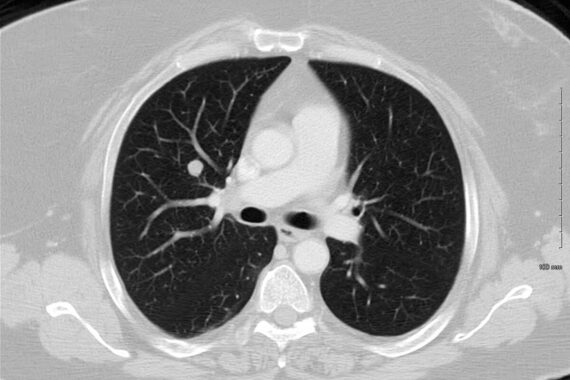Respiratory specialists Ms Hayley Severn and Professor David Baldwin give advice on how to navigate the respiratory medicine referral pathways
Advice and guidance
Advice and guidance (A&G) provides specialised clinical advice prior to or in place of a referral and can provide interim treatment plans while a patient is waiting.
Appropriate uses include:
- Help with diagnosis, such as a pulmonary nodule found on a CT scan. A&G can swiftly resolve the management and relieve anxiety for the patient.
- Management of known chronic conditions such as COPD, interstitial lung disease (ILD), asthma or bronchiectasis. Advice can be provided on improving stable disease, investigations needed and management of exacerbations.
However, A&G is not suitable where:
- Malignancy is suspected.
- Hospital admission is needed (unless there is real uncertainty). A&G should not be used to expedite follow-up appointments.
Referrals for lung and pleural cancers
NICE guidance was last updated in 2015. The criteria (see below) are usually embedded in an urgent electronic referral form. These identify people at higher risk of lung cancer.
It is essential that the smoking history is recorded because this allows better assessment of the need for a CT scan. An intravenous contrast-enhanced CT scan is usually the first test so it is important that the latest renal function (eGFR) is included on the referral. If there is no recent eGFR, this should be checked. Some services offer point-of-care testing but where this is not possible an urgent request for an eGFR would be helpful.
Referral criteria for suspected lung cancer (NICE NG12)
Patients with chest X‑ray findings that suggest lung cancer or who are aged 40 and over with unexplained haemoptysis should be referred on the suspected cancer pathway. Offer an urgent chest X‑ray (within two weeks) to assess for lung cancer if they have two or more of the following unexplained symptoms, or if they have ever smoked and have one or more of the following unexplained symptoms:
- Cough.
- Fatigue.
- Shortness of breath.
- Chest pain.
- Weight loss.
- Appetite loss.
Consider an urgent chest X‑ray (to be done within two weeks) to assess for lung cancer in people aged 40 and over with any of the following:
- Persistent or recurrent chest infection.
- Finger clubbing.
- Supraclavicular lymphadenopathy or persistent cervical lymphadenopathy.
- Chest signs consistent with lung cancer.
- Thrombocytosis.
If a patient has a chest X-ray with findings suggestive of mesothelioma a suspected lung cancer pathway referral should be made.
Offer an urgent chest X‑ray (to be done within two weeks) to assess for mesothelioma in people aged 40 and over if:
- They have two or more of the following unexplained symptoms,
- or they have one or more of the following unexplained symptoms and have ever smoked or have been exposed to asbestos.
The symptoms are:
- Cough.
- Fatigue.
- Shortness of breath.
- Chest pain.
- Weight loss.
- Appetite loss.
Consider an urgent chest X‑ray (within two weeks) to assess for mesothelioma in people aged 40 and over with one of these signs:
- Finger clubbing.
- Chest signs compatible with pleural disease.
Urgent referrals
Urgent referrals can be made electronically if the patient can wait one to two weeks. Examples of these conditions are:
- All patients with suspected tuberculosis.
- Obstructive sleep apnoea in vocational drivers.
- Ongoing COPD, asthma or bronchiectasis exacerbation without deteriorating physiology.
Same-day urgent referrals
More urgent cases need discussion with the on-call respiratory team.
A rapidly evolving condition that requires a decision about hospital admission will often depend on either deteriorating physiology and whether this can be reversed, or the need for an urgent test that cannot be provided in primary care. Social and support factors may also play a role. The degree to which conditions can be managed at home depends on locally available urgent assessment services.
Examples of conditions that require urgent admission for a secondary care test include:
- Suspected acute pulmonary embolism.
- Suspected pneumothorax.
- Suspected acute pneumonia, usually with worrying physiological disturbance or sepsis.
- Unclear diagnosis with deteriorating physiology.
Routine referrals
Where a patient with ongoing symptoms has no clear diagnosis or the ceiling of treatment in primary care has been reached, non-urgent referral is appropriate. It is better if some investigations have been completed in primary care. If a patient has dyspnoea, they might be referred to respiratory or cardiology, so determine this with basic blood tests including a BNP, a chest X-ray and echocardiogram. Services may be provided in secondary care or in the community through integrated care. Examples of presentations include:
- Chronic cough without suspicion of cancer.
- Dyspnoea without suspicion of cancer.
- Lung nodule on CT scan (see also A&G).
- Ongoing symptoms from asthma, COPD, ILD or bronchiectasis.
- Suspected sleep apnoea.
Ms Hayley Severn is lung cancer services specialty general manager at Nottingham University Hospital and Professor David Baldwin is consultant respiratory physician and honorary professor of respiratory medicine at the University of Nottingham













